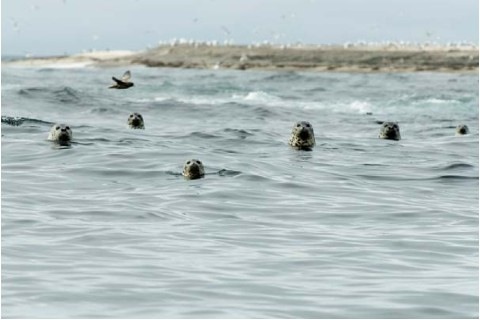
Onekotan Island and Skaly Lovushky - Thursday 16 Aug, 2007
We anchored in the early morning to the north-west of our landing site on Onekotan Island, not that we could actually see it! The fog was thick, and as we boarded our zodiacs in the morning we wondered where on earth our drivers were taking us. Heading expertly (mostly!) in the fog we arrived at the landing site at Nemo Bay on Onekotan Island where we were welcomed ashore and then given the option of a long hike, a medium hike, and a birding walk.
The medium hikers headed up behind the beach over a sand dune that was an old glacial moraine. Behind the moraine were the remains of an ancient Ainu village site. The dwellings were partially underground and their raised circular sides were apparent, even though high grasses covered the site. From there the hikers crossed the small stream and looked at an abundance of wildflowers that were mostly still in full bloom. The rotted remains of a grey whale carcass were a large, undefined, white blob in the middle of the stream. (It was identified because Wayne had seen it more intact the previous year.)
Meanwhile the long hikers headed off up the steep trail, past the remains of the Ainu houses, and across the tundra. Eventually they were treated to views across a small lake and the top of Mt. Hemo, a local volcano. On the way back a down-hill speed sliding competition was devised, and Bud and Cheli both did their part for hillside weed control. Whilst all this was going on the birders headed along the beach spotting a few shorebirds, before also heading up the steep trail into the mist. On the plateau the highlight was the wildflowers, with very few birds in evidence.
Making our way safely back to the ship in the thickening fog, the ship then weighed anchor and headed towards Skaly Lovushky. Rather confusingly we almost had two lunches, as at 12:30 pm we retarded our clocks by an hour and it became 11:30 am againā?¦..time for a second lunch.
During the afternoons cruising Brent gave a lecture on 'Birding 101' - the basics, as well as going over some of the special birds we had seem and will be seeing on this cruise. We learnt that birding is one of the fastest growing pastimes, and is expected to become more popular than golf! Then Daria gave a lecture on the 'Rim of Fire, Volcanoes of the Pacific." She noted that most of volcanoes of Kamchatka, the Kurils, and other parts along the Rim of Fire are andesite strato volcanoes which once in a while have violent explosive eruptions. The name of "andesite" came from Andes, the volcanic mountains along west coast of South America, also part of the Rim of Fire.
Arriving at the small islands of Skaly Lovushky in the late afternoon we boarded the zodiacs for a zodiac cruise. Even before we had left the ship groups of northern fur seals zipped around the boats, peering inquisitively at us. We had hundreds of them zipping all over the place, and could see many hauled out on the rocks. There were also a few Steller's sea lions on the rocks, and a number of them swimming around as well. Large rafts of red-necked phalaropes were also bobbing around on the sea, and fulmars, puffins, and cormorants were also common.
Back onboard into the warmth, the ship then headed south towards Matya and Yankicha Islands.
